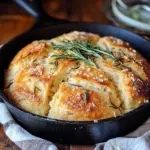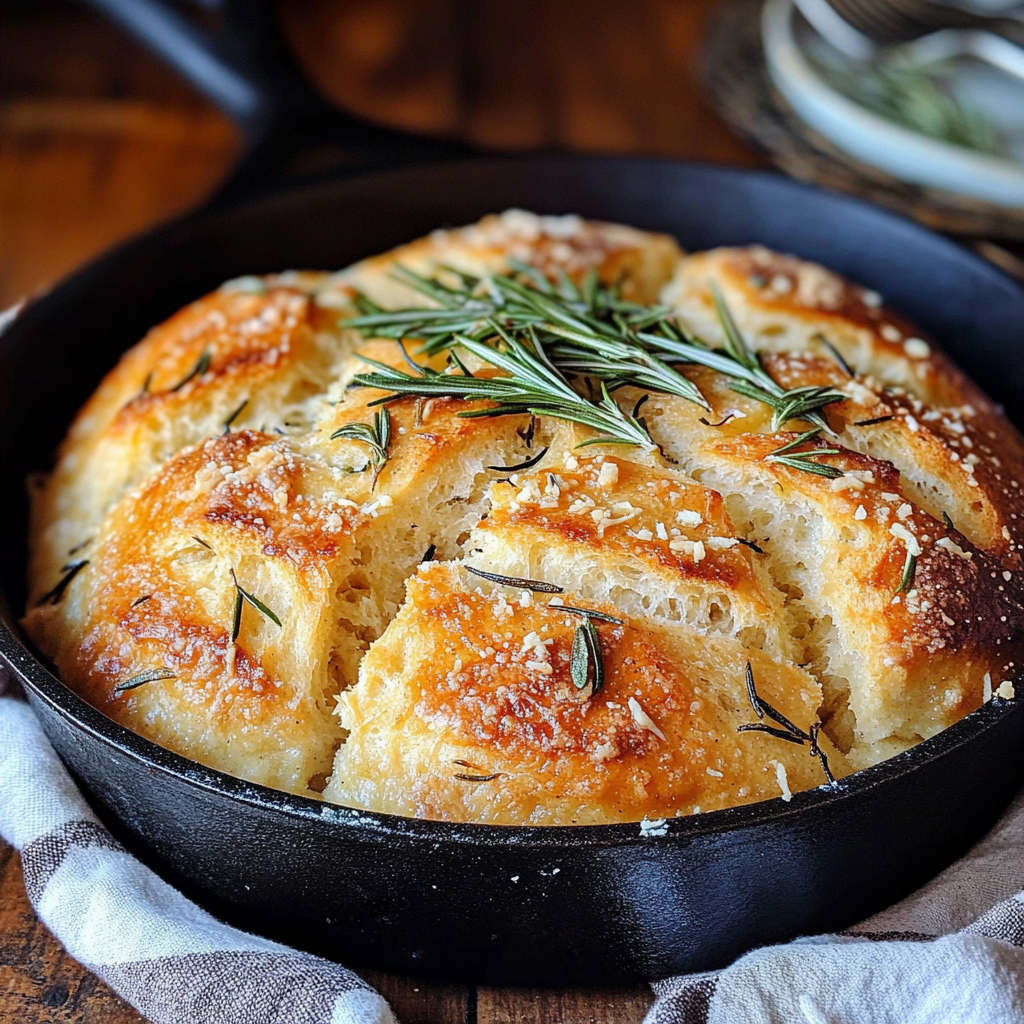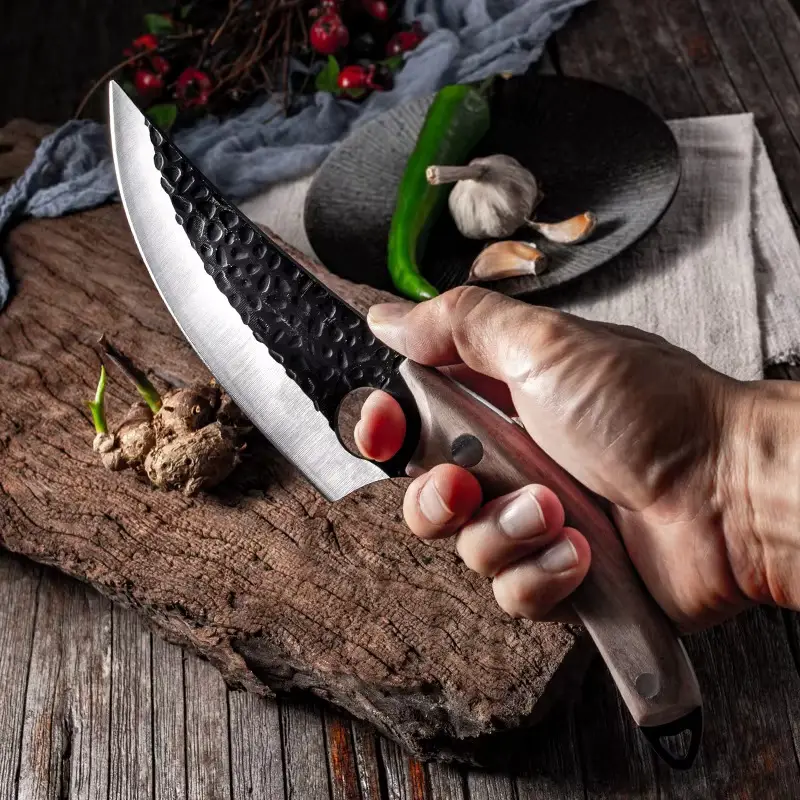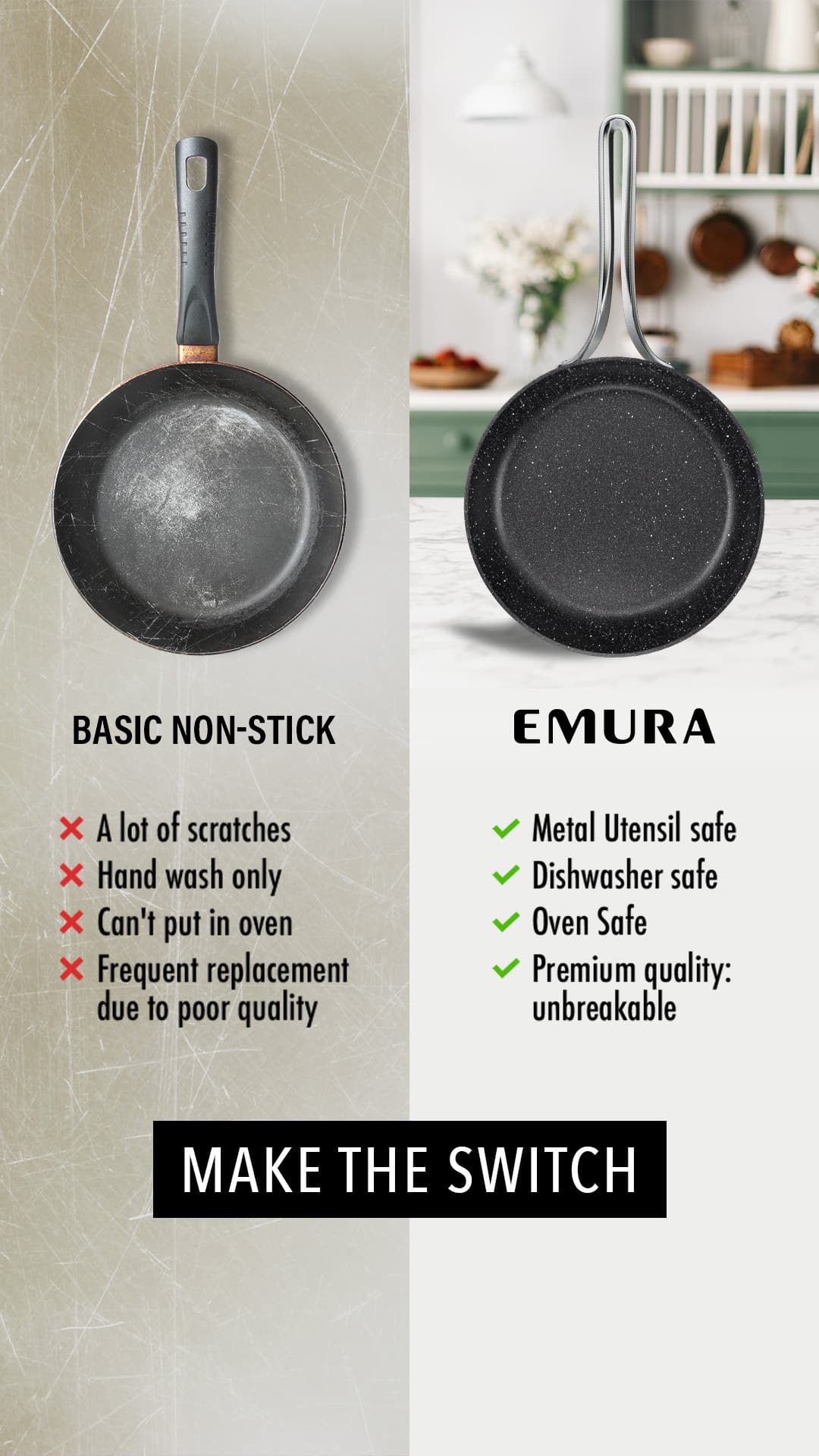No-Knead Rosemary Parmesan Skillet Bread is a foolproof recipe that delivers artisan-quality bread with minimal effort. This rustic loaf boasts a golden, crisp crust, a fluffy interior, and the irresistible aroma of fresh rosemary and Parmesan cheese. The best part? You don’t need any fancy equipment or advanced baking skills. This bread relies on a long fermentation process to develop flavor and texture, so you can simply mix the ingredients, let it rest, and bake to perfection. Whether you’re a seasoned baker or a beginner, this no-knead skillet bread is the perfect recipe to add to your collection. Serve it alongside soups, stews, or salads, or enjoy it as a standalone snack with a slather of butter.
Why You’ll Love This Recipe
No-Knead Rosemary Parmesan Skillet Bread combines the ease of a no-knead recipe with the gourmet flavors of fresh rosemary and Parmesan cheese. This bread is incredibly versatile—it’s perfect as a side dish, a base for sandwiches, or a simple appetizer served with olive oil and balsamic vinegar for dipping. The slow fermentation process enhances the flavor, while baking it in a skillet creates a beautifully crispy crust. Plus, there’s no kneading involved, which means less work and cleanup! If you’ve been intimidated by bread baking, this recipe is an approachable way to achieve bakery-quality results at home.
Preparation Time and Servings
- Prep time: 15 minutes (plus 12-18 hours for dough resting)
- Cook time: 40 minutes
- Total time: 12 hours 55 minutes
- Yield: 1 loaf (8 servings)
- Serving size: 1 slice
Nutritional Information (per serving)
- Calories: 180
- Carbohydrates: 28g
- Protein: 7g
- Fat: 4g
- Fiber: 2g
- Sugar: 1g
Ingredients
For the Dough
- 3 cups all-purpose flour (plus extra for dusting)
- 1 teaspoon salt
- 1 teaspoon sugar
- ½ teaspoon instant yeast (or active dry yeast)
- 1 ½ cups warm water (110°F or 43°C)
- 2 tablespoons fresh rosemary, chopped (or 1 tablespoon dried rosemary)
- ½ cup grated Parmesan cheese
For the Skillet
- 1 tablespoon olive oil (for greasing)
- 1 teaspoon cornmeal (optional, for a textured crust)
For Topping
- 1 tablespoon fresh rosemary, chopped (or ½ tablespoon dried rosemary)
- 2 tablespoons grated Parmesan cheese
- Flaky sea salt (optional)
Step-by-Step Instructions
1. Prepare the Dough
- Mix the Dry Ingredients: In a large mixing bowl, combine the flour, salt, sugar, and yeast. Whisk to ensure everything is evenly distributed.
- Add the Rosemary and Parmesan: Stir in the chopped rosemary and grated Parmesan cheese. These will infuse the dough with flavor as it rests.
- Add the Water: Gradually pour in the warm water and mix with a wooden spoon or spatula until the dough comes together into a sticky, shaggy mass. There’s no need to knead—just ensure there are no dry pockets of flour.
- Cover and Rest: Cover the bowl with plastic wrap or a clean kitchen towel. Let the dough rest at room temperature for 12-18 hours. During this time, the dough will rise and develop bubbles, creating a light, airy texture.
2. Shape the Dough
- Flour the Surface: Generously flour a clean countertop or work surface. Turn the dough out onto the floured surface, using a spatula to scrape it from the bowl.
- Shape the Dough: Dust your hands with flour to prevent sticking, and gently shape the dough into a round ball. Avoid overworking it—handle the dough as little as possible to maintain its airy structure.
- Prepare the Skillet: Grease a 10- or 12-inch cast-iron skillet with olive oil and sprinkle the bottom with cornmeal (if using) to prevent sticking.
3. Let the Dough Rest Again
- Place the Dough in the Skillet: Transfer the shaped dough into the prepared skillet.
- Second Rise: Cover the skillet loosely with a kitchen towel and let the dough rise for 30-45 minutes, or until it puffs up slightly.
4. Preheat the Oven
- Set the Oven Temperature: Preheat your oven to 450°F (230°C). Place an oven-safe lid or aluminum foil on top of the skillet for the first part of the baking process.
5. Bake the Bread
- Bake with the Lid: Bake the bread in the preheated oven for 20 minutes with the lid or foil on. This traps steam, helping to create a soft, airy interior.
- Remove the Lid: After 20 minutes, remove the lid or foil and sprinkle the top of the bread with additional rosemary, Parmesan cheese, and flaky sea salt, if desired. Bake for another 15-20 minutes, or until the top is golden brown and the crust is crispy.
- Check for Doneness: The bread is done when it sounds hollow when tapped on the bottom, or when the internal temperature reaches 200°F (93°C).
6. Cool and Serve
- Cool the Bread: Remove the skillet from the oven and let the bread cool in the skillet for 5 minutes. Then transfer it to a wire rack to cool completely.
- Slice and Enjoy: Slice the bread into wedges or thick slices and serve. This bread pairs beautifully with soups, stews, salads, or simply dipped in olive oil and balsamic vinegar.
Ingredient Background
Flour
All-purpose flour is the foundation of this recipe, creating a tender crumb and light texture. You can also use bread flour for a slightly chewier bread.
Yeast
Instant yeast is used for its convenience, as it doesn’t require proofing. If using active dry yeast, dissolve it in the warm water with the sugar before mixing it with the dry ingredients.
Rosemary
Fresh rosemary adds a fragrant, herbal note to the bread, while dried rosemary works as a substitute if fresh isn’t available. Chop the rosemary finely to distribute it evenly throughout the dough.
Parmesan Cheese
Parmesan cheese adds a nutty, savory flavor that complements the rosemary. Use freshly grated Parmesan for the best flavor and texture.
Olive Oil
Olive oil is used to grease the skillet, adding flavor and helping to achieve a crispy crust.
Technique Tips
- Use a Cast-Iron Skillet: A cast-iron skillet is ideal for this recipe, as it retains heat well and helps create a perfectly crisp crust.
- Room Temperature Rest: Let the dough rest at room temperature for the full 12-18 hours to allow the gluten to develop and the flavors to intensify.
- Gentle Shaping: Handle the dough gently to preserve its airy structure and avoid deflating the bubbles.
- Steam for the Crust: Baking the bread with a lid on traps steam, resulting in a soft interior. Removing the lid during the second half of baking ensures a golden, crisp crust.
Alternative Presentation Ideas
- Mini Loaves: Divide the dough into smaller portions and bake in mini cast-iron skillets or oven-safe ramekins for individual servings.
- Pull-Apart Bread: Shape the dough into small balls and arrange them in the skillet for a pull-apart bread version.
- Cheese-Stuffed Bread: Add chunks of mozzarella or cheddar cheese to the dough for gooey, cheesy pockets in the bread.
Additional Tips for Success
- Plan Ahead: The long resting time means you’ll need to start the dough a day before you plan to bake.
- Check Your Yeast: Ensure your yeast is fresh and active for the best rise.
- Use a Thermometer: An instant-read thermometer ensures the bread is fully baked with an internal temperature of 200°F (93°C).
- Serve Warm: This bread is best served warm, but it can be reheated in the oven to restore its crispy crust.
Recipe Variations
- Garlic Parmesan Bread: Add 1-2 teaspoons of garlic powder to the dough for a garlicky twist.
- Herbed Bread: Use a combination of fresh or dried herbs like thyme, oregano, and basil for a Mediterranean-inspired flavor.
- Sun-Dried Tomato Bread: Fold in chopped sun-dried tomatoes for a tangy, savory addition.
- Spicy Jalapeño Bread: Add finely chopped jalapeños and shredded cheddar cheese for a spicy kick.
Freezing and Storage
- Storage: Store leftover bread in an airtight container or wrapped in aluminum foil at room temperature for up to 2 days.
- Freezing: Wrap the fully cooled bread tightly in plastic wrap and aluminum foil, then freeze for up to 3 months. Thaw at room temperature and reheat in the oven to restore the crust.
Healthier Twist Ideas
- Use whole wheat flour for a nuttier flavor and added fiber.
- Substitute part of the flour with spelt or rye flour for a rustic loaf.
- Reduce the salt slightly to make the bread lower in sodium.
Serving Suggestions for Events
- Appetizer: Serve slices of warm bread with olive oil, balsamic vinegar, and a sprinkle of Parmesan for dipping.
- Side Dish: Pair with creamy soups like tomato bisque or butternut squash soup for a cozy meal.
- Brunch: Top slices with avocado, poached eggs, and a drizzle of hot sauce for a delicious brunch dish.
- Charcuterie Board: Include the bread on a charcuterie board with cheeses, cured meats, and spreads.
Special Equipment
- Mixing Bowl: A large bowl for mixing and resting the dough.
- Cast-Iron Skillet: Essential for achieving a crispy crust and even baking.
- Spatula: For transferring and shaping the sticky dough.
Frequently Asked Questions
Q: Can I use active dry yeast instead of instant yeast?
A: Yes, dissolve active dry yeast in the warm water with sugar and let it sit for 5-10 minutes before mixing with the dry ingredients.
Q: What if I don’t have a cast-iron skillet?
A: You can use any oven-safe skillet or a Dutch oven as a substitute.
Q: Can I make this recipe gluten-free?
A: Substitute a gluten-free all-purpose flour blend, but note that the texture may differ slightly.
Q: How do I make the crust extra crispy?
A: Brush the dough with olive oil or melted butter before baking and bake uncovered for the last 5-10 minutes.
Q: Can I double the recipe?
A: Yes, but you’ll need a larger skillet or multiple skillets to accommodate the extra dough.
Q: Can I add mix-ins like nuts or seeds?
A: Absolutely! Fold in chopped nuts, seeds, or even dried fruit for added texture and flavor.
Conclusion
No-Knead Rosemary Parmesan Skillet Bread is the perfect recipe for anyone who loves freshly baked bread but wants to skip the kneading. With its golden crust, fluffy interior, and delicious combination of rosemary and Parmesan, this bread is a surefire crowd-pleaser. It’s easy to make, versatile, and perfect for any occasion. Whether you’re serving it with dinner, using it for sandwiches, or enjoying it plain, this skillet bread will become a staple in your baking repertoire. Try it today and experience the magic of homemade bread!
Print
No-Knead Rosemary Parmesan Skillet Bread
- Total Time: 12 hours 55 minutes
- Yield: 1 loaf (8 servings) 1x
Ingredients
For the Dough
- 3 cups all-purpose flour (plus extra for dusting)
- 1 teaspoon salt
- 1 teaspoon sugar
- ½ teaspoon instant yeast (or active dry yeast)
- 1 ½ cups warm water (110°F or 43°C)
- 2 tablespoons fresh rosemary, chopped (or 1 tablespoon dried rosemary)
- ½ cup grated Parmesan cheese
For the Skillet
- 1 tablespoon olive oil (for greasing)
- 1 teaspoon cornmeal (optional, for a textured crust)
For Topping
- 1 tablespoon fresh rosemary, chopped (or ½ tablespoon dried rosemary)
- 2 tablespoons grated Parmesan cheese
- Flaky sea salt (optional)
Instructions
1. Prepare the Dough
- Mix the Dry Ingredients: In a large mixing bowl, combine the flour, salt, sugar, and yeast. Whisk to ensure everything is evenly distributed.
- Add the Rosemary and Parmesan: Stir in the chopped rosemary and grated Parmesan cheese. These will infuse the dough with flavor as it rests.
- Add the Water: Gradually pour in the warm water and mix with a wooden spoon or spatula until the dough comes together into a sticky, shaggy mass. There’s no need to knead—just ensure there are no dry pockets of flour.
- Cover and Rest: Cover the bowl with plastic wrap or a clean kitchen towel. Let the dough rest at room temperature for 12-18 hours. During this time, the dough will rise and develop bubbles, creating a light, airy texture.
2. Shape the Dough
- Flour the Surface: Generously flour a clean countertop or work surface. Turn the dough out onto the floured surface, using a spatula to scrape it from the bowl.
- Shape the Dough: Dust your hands with flour to prevent sticking, and gently shape the dough into a round ball. Avoid overworking it—handle the dough as little as possible to maintain its airy structure.
- Prepare the Skillet: Grease a 10- or 12-inch cast-iron skillet with olive oil and sprinkle the bottom with cornmeal (if using) to prevent sticking.
3. Let the Dough Rest Again
- Place the Dough in the Skillet: Transfer the shaped dough into the prepared skillet.
- Second Rise: Cover the skillet loosely with a kitchen towel and let the dough rise for 30-45 minutes, or until it puffs up slightly.
4. Preheat the Oven
- Set the Oven Temperature: Preheat your oven to 450°F (230°C). Place an oven-safe lid or aluminum foil on top of the skillet for the first part of the baking process.
5. Bake the Bread
- Bake with the Lid: Bake the bread in the preheated oven for 20 minutes with the lid or foil on. This traps steam, helping to create a soft, airy interior.
- Remove the Lid: After 20 minutes, remove the lid or foil and sprinkle the top of the bread with additional rosemary, Parmesan cheese, and flaky sea salt, if desired. Bake for another 15-20 minutes, or until the top is golden brown and the crust is crispy.
- Check for Doneness: The bread is done when it sounds hollow when tapped on the bottom, or when the internal temperature reaches 200°F (93°C).
6. Cool and Serve
- Cool the Bread: Remove the skillet from the oven and let the bread cool in the skillet for 5 minutes. Then transfer it to a wire rack to cool completely.
- Slice and Enjoy: Slice the bread into wedges or thick slices and serve. This bread pairs beautifully with soups, stews, salads, or simply dipped in olive oil and balsamic vinegar.
- Prep Time: 15 minutes
- Resting Time: 12-18 hours for dough
- Cook Time: 40 minutes
Nutrition
- Serving Size: 1 slice
- Calories: 180
- Sugar: 1g
- Fat: 4g
- Carbohydrates: 28g
- Fiber: 2g
- Protein: 7g



